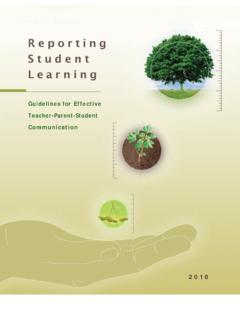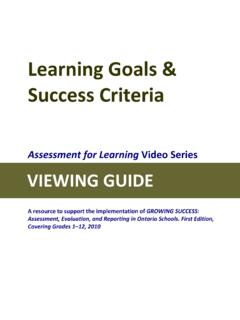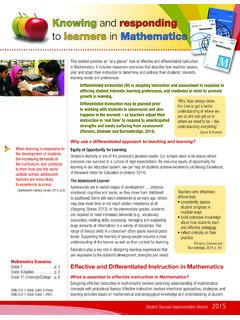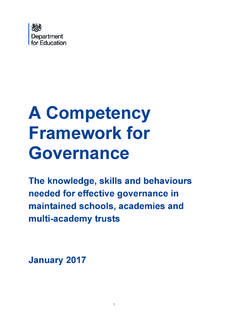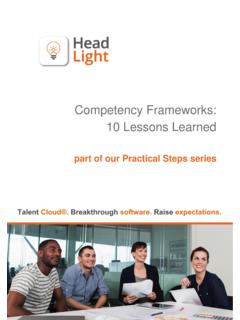Transcription of 21st Century Competencies: Foundation Document …
1 WINTER 2016 EDITION. PHASE 1 Towards Def ining 21s t Centur y competencies for Ontario 21 Century . ST. competencies . Foundation Document FOR DISCUSSION. The Ontario Public Service endeavours to demonstrate leadership with respect to accessibility in Ontario. Our goal is to ensure that Ontario government services, products, and facilities are accessible to all our employees and to all members of the public we serve. This Document , or the information that it contains, is available, on request, in alternative formats. Please forward all requests for alternative formats to ServiceOntario at 1-800-668-9938. (TTY: 1-800-268-7095). CONTENTS. Preface 3. Section One: Introduction 5. Section Two: Defining 21st Century competencies 8. Section Three: The Ontario Context 24. Section Four: Implications for Practice 31. Section Five: Implications for Policy 46.
2 Appendix A: competencies Included in Frameworks across Canada and Internationally 50. Appendix B: The Citizenship Education Framework 52. Appendix C: Ontario's Draft 21st Century / Global competencies 53. References 57. Une publication quivalente est disponible en fran ais sous le titre suivant : Comp tences du 21e Si cle: Document de R flexion. Phase 1: D finir les Comp tences du 21e Si cle pour l'Ontario. dition de l'automne, 2016. PREFACE. Ontario is committed to helping every child and student achieve success and well-being. The primary goal of the province's education system is to enable students to develop the knowledge, skills, and characteristics that will lead them to become personally successful, economically productive, and actively engaged citizens. Researchers acknowledge that the need to engage in problem solving and critical and creative thinking has always been at the core of learning and innovation (Trilling & Fadel, 2009, p.)
3 50). What's new in the 21st Century is the call for education systems to emphasize and develop these competencies in explicit and intentional ways through deliberate changes in curriculum design and pedagogical practice. The goal of these changes is to prepare students to solve messy, complex problems including problems we don't yet know about associated with living in a competitive, globally connected, and technologically intensive world. This Document will provide a focus for discussions among ministry and external education, policy, and research experts about how best to shape provincial policy to help students develop the 21st Century competencies they need to succeed. These discussions will build on the consultations to renew Ontario's vision for education that took place in the autumn of 2013. Key findings from in-depth literature reviews on 21st Century competencies , completed by the Ministry of Education in 2014, are summarized in this Foundation Document .
4 The full in-depth reviews will be made available in the near future. The Document comprises the following five sections: 1. Introduction The rationale for defining and supporting the development of 21st Century competencies . 2. Defining 21st Century competencies A high-level overview of the 21st Century competencies that are most prominently featured in provincial, national, and international research and intellectual debate. 3. The Ontario Context A high-level overview of the work being done in Ontario to identify and define 21st Century competencies in teaching and learning. 3. 4 21st Century competencies 4. Implications for Practice A summary of the new learning partnerships and pedagogical and assessment practices that researchers identify as being required to support the development of 21st Century competencies . 5. Implications for Policy An outline of key questions for consideration in determining policy related to the development of the competencies for the Ontario education system.
5 The overarching questions that have guided the ministry's investigation of 21st Century competencies to date include the following: What are the competencies students need to succeed now and in the future? Which competencies have been most widely accepted by international education thought leaders, scholars, labour market experts, and education jurisdictions? Which methods of classifying the competen- cies contribute most to our understanding of teaching and learning? What does the research tell us about which competencies are most clearly associated with positive outcomes for individuals in many spheres of life, including educational attainment, transitions to postsecondary education and training, employment, and health and well-being? How do other education jurisdictions integrate 21st Century competencies into learning? What is the role of curriculum and other policies and programs in supporting the process?
6 What pedagogical and assessment approaches are necessary to support teaching and learning of the competencies ? How can competencies be assessed, particularly non-cognitive competencies ? What alignments can be made between 21st Century competencies and the existing learning skills and work habits? How can we best prepare educators, leaders, parents, and partners in education for the transformations that may be needed to bring a focus on the competencies into instruction and learning? SECTION ONE. Introduction M any international thought leaders and business leaders and many young people, too are increasingly asking education systems to prepare students with 21st Century competencies1 that will enable them to face complex challenges now and in the future. These competencies knowledge, skills, and attributes that help children and youth to reach their full potential.
7 Are additional to the important foundational skills of literacy and mathematics, and to the core learning in other subjects. What's new about 21st Century competencies ? Changing times are transforming the nature of competencies that have been valuable throughout history, such as communication and collaboration. The nature of collaboration, for example, is evolving to require an increasingly sophisticated set of competencies . As Dede (2010) explains, In addition to collaborating face-to-face with colleagues across a conference table, 21st Century workers increasingly accomplish tasks through mediated interactions with peers halfway across the world whom they may never meet face-to-face. Thus, even though perennial in nature, collaboration is worthy of inclusion as a 21st Century skill because the importance of cooperative interpersonal capabilities is higher and the skills involved are more sophisticated than in the prior industrial era (p.)
8 53). 1. Other labels associated with the term 21st Century competencies include deeper learning , 21st Century skills , global competencies , college and career readiness , student-centred learning , next-generation learning , new basic skills , and higher-order thinking . These labels are typically used to include both cognitive and non-cognitive skills, knowledge, and attitudes. 5. 6 21st Century competencies The reasons why it is increasingly important to focus on 21st Century competencies are multifaceted and well addressed in research studies, but are beyond the scope of this paper to explore in depth. In brief, calls for education systems to keep pace with changing times are often linked to: changes in the work force from an industrial model of production to a rapidly transforming, technology-driven, and interconnected globalized knowledge economy.
9 Such an economy requires competencies suited to dynamic and unpredictable models of economic and social development;. emerging evidence on how to optimize learning, including the use of technological innovations to deepen and transform learning; and changing expectations on the part of learners, who are demanding an education system that is more connected and relevant to their everyday lives. (Tapscott, 1999; Prensky, 2001; Rychen & Salganik, 2001; Levy & Murnane, 2004; Ananiadou & Claro, 2009; Dumont, Istance, and Benavides, 2010;. Dede, 2010; Griffin, McGaw, & Care, 2012; Pellegrino & Hilton, 2012;. Fullan & Langworthy, 2014). The Organisation for Economic Co-operation and Development (OECD) has called on international governments to make an effort to properly identify and conceptualise the set of skills and competencies required so as to incorporate them into the educational standards that every student should be able to reach by the end of compulsory schooling (Ananiadou & Claro, 2009, p.)
10 5). Section One: Introduction 7. Ontario's renewed vision for education, outlined in Achieving Excellence (Ontario Ministry of Education, 2014), articulates a commitment to define and measure 21st Century competencies . This commitment is highlighted by the 2014 Ontario Budget statement that, By 2025 .. Ontario will be a world leader in higher-order skills, such as critical thinking and problem solving, which will allow Ontario to thrive in the increasingly competitive global marketplace (Sousa, 2014, p. 9). Research-based knowledge about 21st Century competencies is dynamic and evolving. To remain current with developments in this field, Ontario is committed to periodic reviews of the research and ongoing revisions of previous perspectives. In this context, Ontario has the opportunity to take a leading role in identifying the 21st Century competencies that will be of benefit to all students, while acknowledging the need to review and revise its understanding as we learn our way forward.

